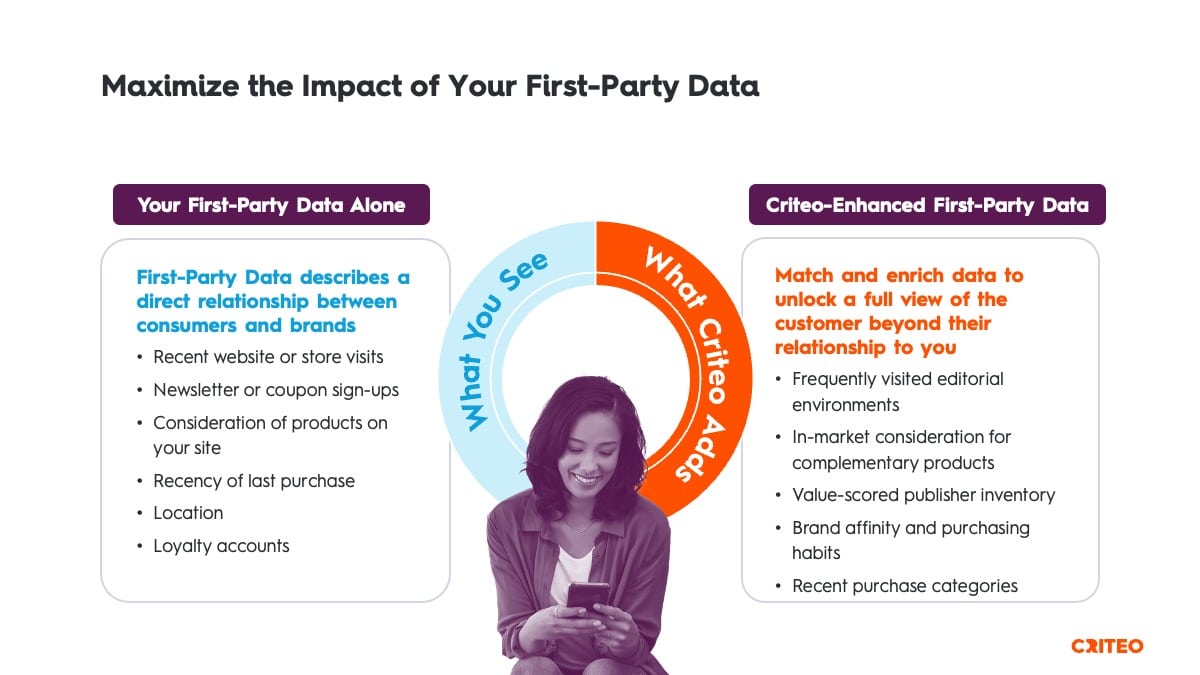One of the top questions our clients ask is how to navigate the post-third-party cookie advertising landscape. Since the early days of the consumer internet, third-party cookies have played a role in delivering relevant ads to consumers, creating a lingua franca as a means for all parties to communicate across the advertising ecosystem. This common language has begun to gradually disappear and will continue to be phased out through 2024, posing a risk to how marketers are able to communicate with consumers. But a stronger addressable future is possible with the right, multifaceted approach.
The lingering question is, as our common language fades away, how will marketers and media owners communicate with consumers? Criteo has been careful to invest in a variety of new addressability solutions, each emphasizing the ability to meet our partners needs for scale, precision, and economics, along with privacy preservation for our entire ecosystem. We’re confident in the strategy and products we have in place to meet these demands, and in this post, I’ll share more details about how we’re approaching the future of addressability.
There Will Be More Than One “Cookie Replacement”
Following Google’s announcement about deprecating third-party cookies on Chrome, numerous companies doubled down on proprietary identifiers as a replacement. Of all these, it’s clear that we are not looking at a “this-for-that” substitution. Largely, these identifiers are probabilistic and therefore not sustainable for all parties as they are dependent on gatekeepers and further browser restrictions. Many maximize addressability within the confines of a single organization while failing to interoperate with the rest of the ecosystem, limiting their scale. Unless an identifier is interoperable, it will promote industry fragmentation through its own proprietary “language.”
The future of addressability will not hinge on a single branded identifier but instead be built on solutions that are scalable, open-source, and rely on consumer consent. On top of reaching directly addressable consumers who share their email addresses for marketing purposes, the future will also integrate non-identity-derived solutions to reach non-addressable consumers who do not have a recognized ID. These solutions will function across the entire demand and supply chain to provide greater value to consumers and enable marketers to achieve stronger performance.
A Better Path Forward for Marketers
Given the need for diverse solutions, marketers must adopt a multifaceted approach to engage with both directly addressable and non-addressable consumers using targeted ads. At the core of this approach is first-party data matching. Successful brands will enrich their own first-party data by integrating it with other data sets, including first-party contextual signals, to gain a deeper understanding of their target audience and address them with tailored messaging.
Hashed emails, which are pseudonymous IDs, are proving to be effective for marketers as they provide privacy-protected, common means of identifying individual consumers. Essentially acting as a technical “nom de plume,” they enable marketers to identify consumers without collecting personally identifiable information. Hashed emails are also simple for marketers to leverage, as they are the only universal tool to help data sets from marketers and media owners communicate without requiring complex integrations or partnerships. By matching data across demand and supply, hashed emails create a unified ID ecosystem, allowing for a common language that supports scaling and facilitates access to targeting and measurement capabilities.
Several of our clients are already seeing improved performance with hashed emails, while also safeguarding their future strategies. As nearly a quarter of the internet already operates without third-party cookies today, a natural A/B testing environment exists within browsers that no longer support cookies. These environments include Safari and Firefox, in comparison to Chrome, which still relies on cookies. A recent win included a client seeing a 52% increase in revenue when utilizing hashed emails on Firefox and Safari.
Criteo’s Multi-Pronged Addressability Solution
Our team has spent years preparing for a future without third-party cookies if and when they are deprecated. Through a concerted effort across the organization, we developed a multi-pronged approach, with solutions designed to interplay with each other to enhance engagement and increase relevance for both addressable and non-addressable consumers, both today and in the future.
To engage directly-addressable consumers in cookieless environments, our First-Party Media Network onboards first-party data from both marketers and media owners, which we connect through common IDs — mainly hashed emails — enabling marketers to leverage consumers’ commerce data to recommend useful products and services to them. And this workflow ensures consumer privacy and data protection for our partners. This approach allows us to help marketers target Commerce Audiences, or active, high shopping-intent consumers who are most likely to make purchases in a specific product or brand category. We find these best-fit Commerce Audiences for our clients by leveraging our powerful, commerce-focused AI solutions, which we’ve refined over the last 18 years.
We’ve also been working side by side with Google Chrome in the Privacy Sandbox to ensure the output of their efforts results in a privacy-preserving solution for our clients that provides precision, scale, and viable economics. The Privacy Sandbox covers both Chrome for the web, and the Android in-app ecosystem. For both, Google has proposed a set of solutions for audience definition and bidding, such as TOPICS and Protected Audiences, and another set for reporting and campaign optimization, such as Attribution Reporting API.
Chrome has made those solutions available for a 5% share of traffic, and Criteo is using them at scale, making bids and displays through the Privacy Sandbox. We are ready for the next phase, when the Privacy Sandbox solutions will be available for all Chrome users, which represents billions of consumers. We remain one of the largest scaled partners in the Privacy Sandbox, and we are very encouraged by our productive collaboration and results to date. We’re also testing essential functionalities for bidding, reporting, and attribution, and working directly with industry groups like IAB France, the W3C, and regulators to address specific marketer needs.

To engage non-addressable consumers, we use supervised machine learning that interplays with first-party data for personalization capabilities. We continuously test and enhance this machine learning to reveal uncommon connections between data sets, consumer behaviors, online content, and shopping outcomes — even without the presence of third-party cookies. Additionally, we can layer first-party data with thousands of real-time contextual signals, linking marketers’ campaigns to the most relevant content based on directly observed shopping outcomes. Our advanced AI and machine learning technology is then used to activate this data and recommend and scale audiences for our clients.
Our privacy-proofed AI learns from the billions of data points that make up our robust commerce dataset often referred to as our “truth set.” This reciprocal relationship of data and AI allows us to exercise precision when discovering these potential customers across all channels, devices, and stages of their shopping journey, as well as enriching our clients’ first-party data. By adding nuance to clients’ data, we provide a more comprehensive view of consumer buying and browsing behaviors beyond their own first-party data.
For instance, Criteo can work with a furniture store to uncover hidden audiences who are currently searching for a new apartment, or recently graduated. The furniture store would not have otherwise known that the consumer’s next stop after signing a lease is hunting for a new couch, but with our advanced AI solutions and commerce data access, they now do.
These solutions are already in motion today, and we’re testing even more supplemental inputs as they emerge in market, so that we’re constantly evolving and maintaining pace with changes in the regulatory and identity landscape. All of these solutions also focus on increasing interoperability across the ecosystem for more efficiency and scale.
How Marketers Can Prepare Now
The deprecation of third-party cookies on Chrome is just around the corner, as Google will remove them across 1% of Chrome’s traffic in Q1 of next year. We see this as progress towards acquiring even more robust data to continue optimizing our clients’ addressability strategies. As marketers prepare for the future of addressability, it’s also crucial to focus on customer segmentation when leveraging first-party data, with a renewed focus on addressable customers, as well as non-addressable prospects and site visitors who may not have a known email address. Marketers can then choose a DSP that supports all three in a consistent and scalable way on the open internet.
At Criteo, we deliver performance across all of these consumer categories and offer our partners tailored guidance on data onboarding to optimize campaigns for the future of addressability. We advise our clients on steps they can take today that will help steer them in the right long-term direction for their own future-proofing strategies, including maximizing their first-party data strategy. Marketers can focus on securing data on their own properties through email signups, promotions, and reminders, in ways that add value to their customers’ journeys.
Right now, marketers can also take advantage of the A/B testing opportunities available by advertising in environments which don’t rely on third-party cookies like Safari and Firefox. By implementing these strategies, marketers can adapt to the evolving landscape while still delivering effective, relevant, and privacy-protected advertising to consumers.
Final Thoughts
Addressability without cookies is an evolving discussion, but with the right approach, marketers can still deliver relevant advertising experiences to consumers while safeguarding their privacy. Collaboration within the industry, combined with a focus on consumer choices, will be key to unlocking new solutions for addressability. By working together with partners and staying current on the latest developments, marketers can continue to connect with their audiences in meaningful ways, both today and in the future.
Talk with one of our experts on how to prepare for the future of addressable advertising or read on for our R&D team’s insights on the initial testing of Google Privacy Sandbox.






















